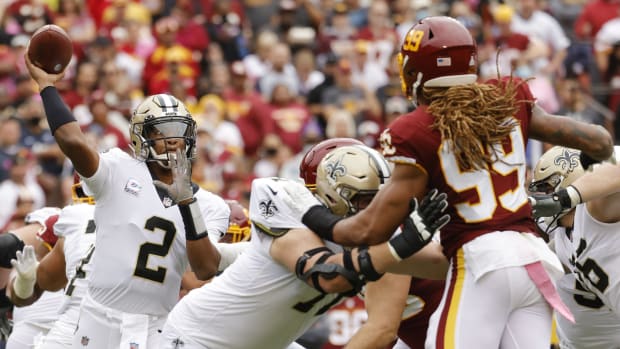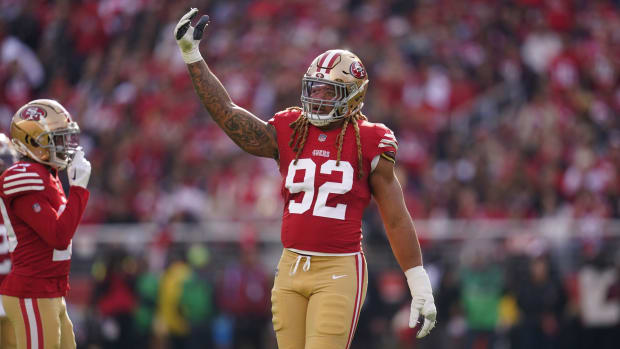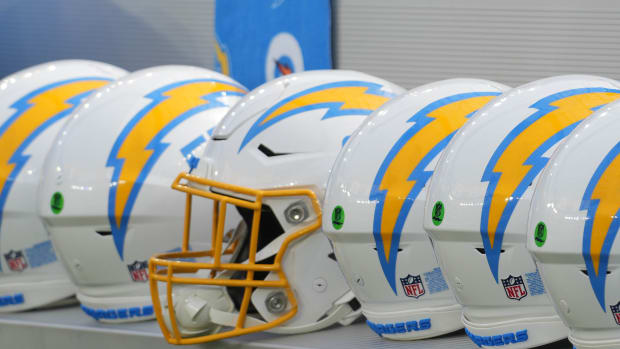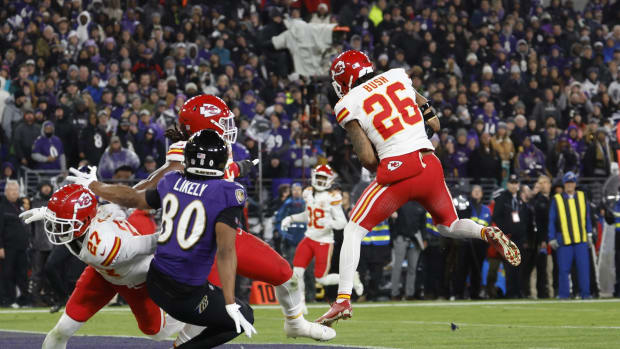A Football Feast
In last season's two games against the Packers, Calvin Johnson had 15 catches for 264 yards and one touchdown ... but the Lions lost both. (Leon Halip/Getty Images)
Going past the obvious storylines and taking a deeper dive into all three Thanksgiving games in Week 13. (All times Eastern.)
Packers (5-5-1) at Lions (6-5), 12:30 p.m., FOX
Packers offense vs. Lions defense
The Hollywood narrative would suggest Matt Flynn is primed for an Earth-moving performance. The former-Packer-turned-journeyman-turned-Packer is on the Thanksgiving stage and facing a Lions team that he torched for 480 yards and six touchdowns in a meaningless Week 17 contest two years ago. That performance helped bring Flynn a not-so-meaningless eight-figure contract in free agency, but it has also turned out to be the former seventh-round pick’s last taste of NFL success.
Since that game, Flynn has endured a tacit but public rejection from his former offensive coordinator (and current Dolphins head coach) Joe Philbin; lost quarterback competitions in Seattle and Oakland (after opening both as the heavy favorite); been released after short stays in Oakland and Buffalo; and, most recently, been written off as damaged goods by a litany of NFL clubs.
Now Flynn is starting again—presumably with, as the narrative goes, “a chip on his shoulder.” Too bad Aaron Rodgers can’t start with a chip on his shoulder. In real life, quarterbacks can’t ride motivation to victory. Motivation doesn’t amplify arm strength. Or size. Or mobility. Or sense of passing lane anticipation. All are significant attributes Flynn lacks.
A quarterback’s physical limitations are most exposed when he’s under pressure. We saw several examples of this late in overtime last Sunday, when Minnesota’s front four took it to Green Bay’s offensive line. On multiple dropbacks, Flynn couldn’t come close to getting the ball downfield.
Like Minnesota, Detroit’s defense is built around a dynamic front four. When the Packers and Lions met in Week 5, the Packers frequently kept in extra blockers to help unpolished offensive tackles David Bakhtiari and Don Barclay. Though both young linemen have since flickered signs of improvement, they remain ill-equipped to combat the explosive Nick Fairley and Ndamukong Suh, or the just-plain-fast Willie Young and Ziggy Ansah. (Ditto for Marshall Newhouse, who will make a third straight start at right tackle Thursday if Barclay remains sidelined with a bum knee.)
The Lions essentially refrained from all blitzing in the Week 5 meeting, which is not atypical of a Jim Schwartz team. They did, however, diversify their coverages, straying from their usual two-deep zones to incorporate more man-to-man. We probably won’t see that this time around. For one, teams playing on a shorter week are more likely to stick with what’s familiar. For Detroit, that means Cover 2 and Cover 3 zones. For two, with Flynn unlikely to conjure big plays on his own, and with Randall Cobb and Jermichael Finley out of action, Schwartz should have confidence that his defense can simply line up and out-execute Green Bay.
Lions offense vs. Packers defense
The Packers last faced Calvin Johnson in 2012. They defended him with Tramon Williams’ man coverage and, usually, a safety over the top. Johnson finished with 143 yards on five catches in the first meeting. In the second, he faced more one-on-one scenarios and caught 10 balls, but for only 118 yards.
This season, Sam Shields has emerged as Green Bay’s best cover man, though lately he’s been dealing with a bad hamstring. If Shields, who did a spectacular job against A.J. Green in Week 3, can’t handle Johnson, Williams will once again get the nod.
Regardless of who stalks Johnson, Detroit’s offense won’t click until Matthew Stafford recalibrates. He threw four interceptions against Tampa Bay—two on inaccurate throws underneath and two on forced balls to a double-teamed Megatron. The prior week, Stafford missed several open targets in a loss at Pittsburgh.
Lions offensive coordinator Scott Linehan must recommit to the quick-strike passing that worked early in the season. That will force Stafford to play with more discipline. Plus, for this matchup, it’s a good way to nullify the corner blitzes that Green Bay loves to bring.
In two starts for the Raiders this season, Matt McGloin is 1-1 with four touchdowns and one interception. (Thearon W. Henderson/Getty Images)
Raiders (4-7) at Cowboys (6-5), 4:30 p.m., CBS
Raiders offense vs. Cowboys defense
Just like last week, Raiders coach Dennis Allen is starting Matt McGloin based on merit. But whose merit? McGloin’s? Or Terrelle Pryor’s lack thereof? McGloin was respectable, maybe even impressive, starting in place of an injured Pryor against Houston. And he was productive starting in place of a healthy Pryor against Tennessee. Without question, this offense functions smoother with the undrafted rookie under center. While Pryor on most downs immediately free-styles at the top of his drop, McGloin actually stays in the pocket and reads the field. That gives passing plays a chance to work the way they’re designed, which gives the Raiders a chance to actually build rhythm.
This doesn’t mean McGloin is a savior. As you’d expect from an undrafted QB, he has some conspicuous shortcomings. Most notably, arm strength and footwork. This will lead to challenges; the more a quarterback’s weaknesses show up on film, the more ways defenses figure out how to exploit them.
The way to exploit a meager arm and unrefined feet is with pressure. McGloin is a snappy decision-maker, so the pressure must get there early. The Cowboys only have two players who can generate fast pressure: DeMarcus Ware and Jason Hatcher. That should suffice against Oakland’s O-line. Left tackle Khalif Barnes struggles with leverage on the outside; right tackle Tony Pashos is heavy-legged; rotational backup Menelik Watson, a second-round rookie underclassman, has no idea how to use his hands; and left guard Lucas Nix doesn’t move well laterally.
Dallas’ defense is allowing 299 passing yards per game, which is one yard behind Philly for worst in the NFL. But this D also has forced 22 takeaways, third most in the NFC. There will be chances to build on that total if the front four can get to McGloin. First, though, the Cowboys must stop the run—something they haven’t done since Sean Lee pulled his hamstring three weeks ago. Raiders running back Rashad Jennings is a surprisingly effective downhill runner, including from shotgun.
Cowboys offense vs. Raiders defense
Every quarterback looks forward to facing Raiders strong safety Brandian Ross. The young ex-Packer was pushed into the starting lineup when Tyvon Branch broke his leg in September. Since then, there have been several instances where Ross has looked like he’s witnessing a forward pass for the first time in his life. Much to Tony Romo’s glee, there’s a good chance Ross will be matched on Jason Witten.
Deep safety Charles Woodson is likely to cheat his coverage towards Dez Bryant, which means the Witten-Ross matchup could be a true one-on-one, depending on how defensive coordinator Jason Tarver elects to play. Tarver has used fewer coverage disguises and rotations the past few weeks, replacing some of Oakland’s man-to-man concepts with more Cover 2.
Whichever way the Raiders go, expect the Cowboys to make good use of the three-wideout, two-tight end empty sets that have become their identity. Those spread sets will serve to either widen the Cover 2 zone voids or create extra ground for defensive backs to traverse in their rotations and disguises. The risk with a 3 x 2 spread is there can only be five linemen to protect Romo. That’s not a problem against the Raiders. Bull-rusher Lamarr Houston is the only semi-viable threat up front, and he won’t do much against bourgeoning left tackle Tyron Smith.
Terrell Suggs and the Ravens defense's ability to pressure Ben Roethlisberger could tell the story of Thursday's game in Baltimore. (George Gojkovich/Getty Images)
Steelers (5-6) at Ravens (5-6), 8:30 p.m., NBC
Steelers offense vs. Ravens defense
If Pittsburgh copies the game plan it used in narrowly defeating Baltimore in Week 7, then maligned offensive tackle Mike Adams will see about 20 snaps as a sixth lineman, mainly on first and second down. Adams has prospered as a sixth man, as the Steelers have used more heavy fronts to not only ignite their ground game but also create more opportunities in the air. With an extra body in this piecemeal O-line, Ben Roethlisberger has finally had time to consistently complete his dropbacks.
With Roethlisberger, this often means he has time to extend the play, which is what he does best. In Week 7, the Ravens played to this strength by eschewing the blitz and keeping two safeties deep in obvious passing situations. Presumably, they believed that Terrell Suggs and Elvis Dumervil could generate edge pressure even against max protection. That’s not illogical given Pittsburgh’s blocking woes or given Baltimore’s potency inside with pliable nickel tackle Pernell McPhee and strong men Haloti Ngata and Chris Canty. But it also wouldn’t be illogical for the Ravens to bring extra heat on Roethlisberger and make his six-man line prove it can sort blitz pickups.
As every defense has learned, pressuring Roethlisberger does not guarantee stopping him. But this season, when the pressure has shown up consistently, Pittsburgh’s passing game has sputtered. That’s why Haley must stay balanced and feed running back Le’Veon Bell, even if it’s tough sledding against a Ravens defense that’s giving up fewer yards per run than all but four teams.
Ravens offense vs. Steelers defense
The Ravens won’t be able to run against the Steelers because, aside from the reeling Bears, the Ravens haven’t been able to run against anybody this season. Ray Rice is averaging a mind-boggling 2.9 yards per carry and 45 yards per game. His backup, Bernard Pierce, who was a top-20 back last season, is averaging 2.7 yards per carry and 28.1 yards per game. Neither guy has looked good on film, but neither has enjoyed great blocking, either.
Though the running game is anemic, play-action remains a lethal element of Baltimore’s offense. Joe Flacco, like all quarterbacks these days, will use hard run-action fakes to set up quick slants. But Flacco remains most dangerous on the old-school play-action deep drops, where he rolls out and looks for Torrey Smith or Jacoby Jones downfield. Flacco’s play-action numbers rank in the middle-of-the-pack, but no intelligent defensive coach would read much into that. Play-action bombs are how the Ravens try to kill opponents.
Pittsburgh’s defense, with its slew of veterans and shrewd matchup-zone coverages, has long been the NFL’s best at stopping potentially big plays. Last season, it held offenses to 0 for 30 passing on balls that traveled at least 30 yards through the air.
This season, however, the Steelers have surrendered six completions on balls traveling 30 yards, and they’ve given up a total of 10 passes that have gone 40-plus yards, seventh most in the league. (Interesting side note: Baltimore’s defense has surrendered an NFL-worst 15 passes of 40 yards or more, though nine of them were concentrated in three games).
Pittsburgh’s big-play slippage is explainable. Shutdown cornerback Ike Taylor has been up-and-down the past month or so; No. 2 corner Willie Gay has been a downgrade from Keenan Lewis after all; safety Ryan Clark has uncharacteristically fallen for a handful of deceptive aerial tactics; and Troy Polamalu has been caught guessing wrong a few times. Exacerbating these hiccups is the continued slide into mediocrity by Pittsburgh’s once-vaunted pass rush (it most recently ranked 23rd in MMQB’s Pressure Points).








































